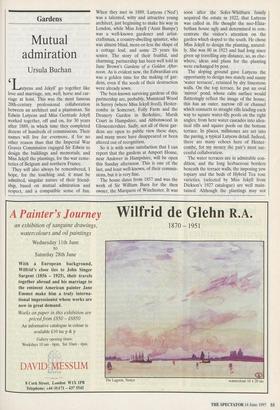Gardens
Mutual admiration
Ursula Buchan
Lutyens and Jekyll' go together like love and marriage, urn, well, horse and car- riage at least. This was the most famous 20th-century professional collaboration between an architect and a plantsman. Sir Edwin Lutyens and Miss Gertrude Jekyll worked together, off and on, for 30 years after 1889, in which time they completed dozens of hundreds of commissions. Their names will live for evermore, if for no other reason than that the Imperial War Graves Commission engaged Sir Edwin to design the buildings and memorials, and Miss Jekyll the plantings, for the war ceme- teries of Belgium and northern France.
They will also always be remembered, I hope, for the touching and, it must be admitted, singular nature of their friend- ship, based on mutual admiration and respect, and a compatible sense of fun. When they met in 1889, Lutyens ('Ned') was a talented, witty and attractive young architect, just beginning to make his way in London, while Miss Jekyll (`Aunt Bumps') was a well-known gardener and artist- craftsman, a country-dwelling spinster, who was almost blind, more-or-less the shape of a cottage loaf, and some 25 years his senior. The story of their fruitful, and charming, partnership has been well told in Jane Brown's Gardens of a Golden After- noon. As is evident now, the Edwardian era was a golden time for the making of gar- dens, even if the seeds of their destruction were already sown.
The best-known surviving gardens of this partnership are, probably, Munstead Wood in Surrey (where Miss Jekyll lived), Hester- combe in Somerset, Folly Farm and the Deanery Garden in Berkshire, Marsh Court in Hampshire, and Abbotswood in Gloucestershire. Sadly, not all of these gar- dens are open to public view these days, and many more have disappeared or been altered out of recognition.
So it is with some satisfaction that I can report that the gardens at Amport House, near Andover in Hampshire, will be open this Sunday afternoon. This is one of the last, and least well-known, of their commis- sions, but it is very fine.
The house dates from 1857 and was the work of Sir William Burn for the then owner, the Marquess of Winchester. It was soon after the Sofer-Whitburn family acquired the estate in 1922, that Lutyens was called in. He thought the neo-Eliza- bethan house ugly and determined to con- centrate the visitor's attention on the garden which sloped to the south. He chose Miss Jekyll to design the planting, natural- ly. She was 80 in 1923 and had long since given up travelling any distance, so, as else- where, ideas and plans for the planting were exchanged by post.
The sloping ground gave Lutyens the opportunity to design two stately and sunny `water terraces', retained by dry limestone walls. On the top terrace, he put an oval `mirror' pond, whose calm surface would flatteringly reflect the image of the house; this has an outer, narrow rill or channel which connects to straight rills leading each way to square water-lily pools on the right angles; from here water cascades into iden- tical rills and square pools on the bottom terrace. In places, millstones are set into the paving, a typical Lutyens detail. Indeed, there are many echoes here of Hester- combe, for my money the pair's most suc- cessful collaboration.
The water terraces are in admirable con- dition, and the long herbaceous borders beneath the terrace walls, the imposing yew topiary and the beds of Hybrid Tea rose varieties, (selected by Miss Jekyll from Dickson's 1927 catalogue) are well main- tained. Although the plantings may not now be strictly original, they are still markedly Jekyllian, with what might be called signature plants, such as bergenias, lavender, nepeta, lychnis and kniphofia (red-hot pokers), planted in characteristic drifts.
The gardens were not entirely shaped by Lutyens. To the west of the water terraces is a bravura 'orchard' of pleached lime trees (amounting to a mile in length) and there is a parterre, laid out in Victorian times, and filled with clipped box, in the shape of the Marquess of Winchester's coat of arms. That said, it is the water terraces which linger in the mind, for they are a marvellous example of Lutyens's geometric garden style, softened and enhanced by Miss Jekyll's ebullient and harmonious planting. Anyone who cares to make the trip to Amport this Sunday has a golden afternoon in prospect.
The garden is open on 15 June from 2 until 5 p.m., admission B, in aid of the National Gardens Scheme.











































































 Previous page
Previous page